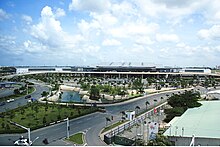User:Dragfyre/Sandbox/Transport in Ho Chi Minh City
Ho Chi Minh City Department of Transportation and Public Works
Air[edit]

Ho Chi Minh City is served by Tan Son Nhat International Airport, located in Tan Binh District. Tan Son Nhat Airport is currently the largest airport in Vietnam in terms of passengers handled (with an estimated number of over 15.5 million passengers per year in 2010, accounting for more than half of Vietnam's air passenger traffic[1][2]); it will soon be superseded by Long Thanh International Airport, scheduled to begin operation in 2025. Based in Long Thanh, Dong Nai Province, about 40 km northeast of Ho Chi Minh City, Long Thanh Airport will serve international flights, with a maximum traffic capacity of 100 million passengers per year when fully completed;[3] Tan Son Nhat Airport will serve domestic flights.
Rail[edit]
Ho Chi Minh City is also a terminal for many Vietnam Railways train routes in the country. The Reunification Express (tàu Thống Nhất) runs from Ho Chi Minh City to Hanoi from Saigon Railway Station in District 3, with stops at cities and provinces along the line.
Light rail[edit]
The Ho Chi Minh City Metro, a light rail rapid transit network, is currently in the preparation stages, with the first line currently under construction, to be completed by 2014. This first line will connect Ben Thanh Market to Suoi Tien Park in District 9, with a depot in Long Binh. Planners expect the route to serve more than 160,000 passengers daily.[4] A line between Ben Thanh and Tham Luong in District 12 has been approved by the government,[5] and several more lines are currently the subject of feasibility studies.[4]
Water[edit]
Inland waterways[edit]
The city's location on the Saigon River makes it a bustling commercial and passenger port; besides a constant stream of cargo ships, passenger boats operate regularly between Ho Chi Minh City and various destinations in Southern Vietnam and Cambodia, including Vung Tau, Can Tho and the Mekong Delta, and Phnom Penh. Traffic between Ho Chi Minh City and Vietnam's southern provinces has steadily increased over the years; the Doi and Te Canals, the main routes to the Mekong Delta, receive 100,000 waterway vehicles every year, representing around 13 million tons of cargo. A project to dredge these routes has been approved to facilitate transport, to be implemented in 2011–2014.[6]
International shipping[edit]
This section needs expansion. You can help by adding to it. |
Cruise ships[edit]
This section needs expansion. You can help by adding to it. |
Road[edit]
Infrastructure[edit]
Highways[edit]
This section needs expansion. You can help by adding to it. |
- National Route 1A (Vietnam)
- National Route 13 (Vietnam)
- National Route 22 (Vietnam)
- National Route 51 (Vietnam)*
- North-South Expressway, Vietnam
- Ho Chi Minh City – Long Thanh – Dau Day Expressway
Bridges[edit]
Tunnels[edit]
Inner city transport[edit]

The main means of transport within the city are motorbikes, buses, taxis, and bicycles. Motorbikes remain the most common way to move around the city.[citation needed] Taxis are plentiful and usually have trip meters, although it is also common to agree on the trip price before taking a long trip, for example, from the airport to the city centre. Public buses run on many routes and fare can be purchased on the bus. For short trips, "xe ôm" (literally, "hug vehicle") motorcycle taxis are available where the passenger sits at the rear of a motorbike. A popular activity for tourists is a tour of the city on cyclos, which allow for longer trips at a more relaxed pace. For the last few years, cars have become more popular.
City buses[edit]
This section needs expansion. You can help by adding to it. |
Taxis[edit]
This section needs expansion. You can help by adding to it. |
Development[edit]
This section needs expansion. You can help by adding to it. |
The Ho Chi Minh City Metro was first proposed in 2001[7] as part of a comprehensive public transport network plan including Ho Chi Minh City and neighbouring provinces, with the aim of avoiding the severe traffic congestion problems that have affected other Asian cities (such as nearby Bangkok).[8] Most of the network is currently in the planning stages, with projects for different lines advancing as funds become available. The network's first line, connecting Bến Thành Market and Suoi Tien Park in District 9, is scheduled for completion in 2015.[9] Construction of a second line began in August 2010; completion is scheduled in 2012.[10]
See also[edit]
Notes and references[edit]
- ^ Expansion of Saigon – Tan Son Nhat International Airport on Sài Gòn Giải Phóng Newspaper on October 13, 2007 [1]
- ^ Two more Hanoi<>Saigon flights per day for Pacific Airlines on “Vietnamnet.net, access date November 11, 2007, (in Vietnamese) [2]
- ^ "Airport Development News" (PDF). Retrieved May 19, 2008.
- ^ a b "Ho Chi Minh City Metro". Railway-technology.com. Retrieved April 4, 2010.
- ^ Dinh Muoi. "HCMC's subway route No.2 approved". Thanh Nien.
- ^ Vietnam News Service. "City to expand waterway transport". Vietnam News.
- ^ Robert Schwandl (2007). "Ho Chi Minh City Metro". Urbanrail.net. Retrieved 2010-05-26.
- ^ "Ho Chi Minh City plans to build a metro network". International Railway Journal. 2002-05-01. Retrieved 2010-05-27.
- ^ "The work begins: HCM City to have first subway in 2015". VietnamNet Bridge. 2010-04-30.
- ^ "Work starts on Ho Chi Minh City metro line - International Railway Journal". 2010-08-24. Retrieved 2010-08-24.
